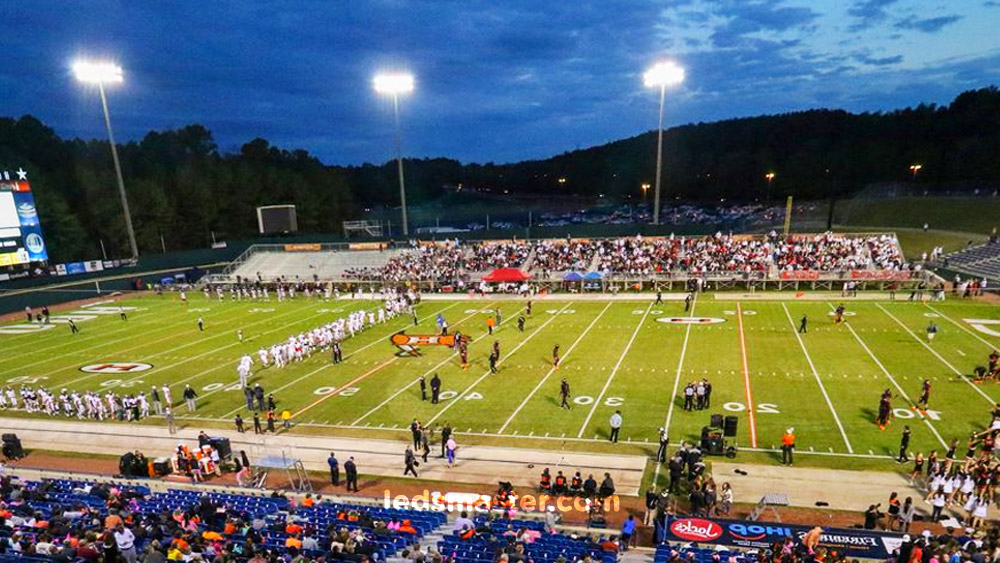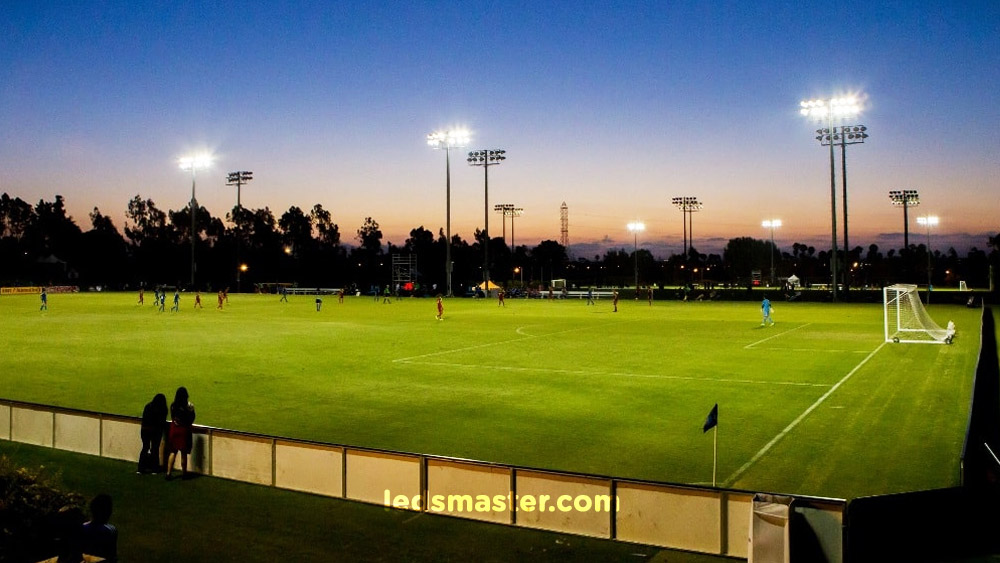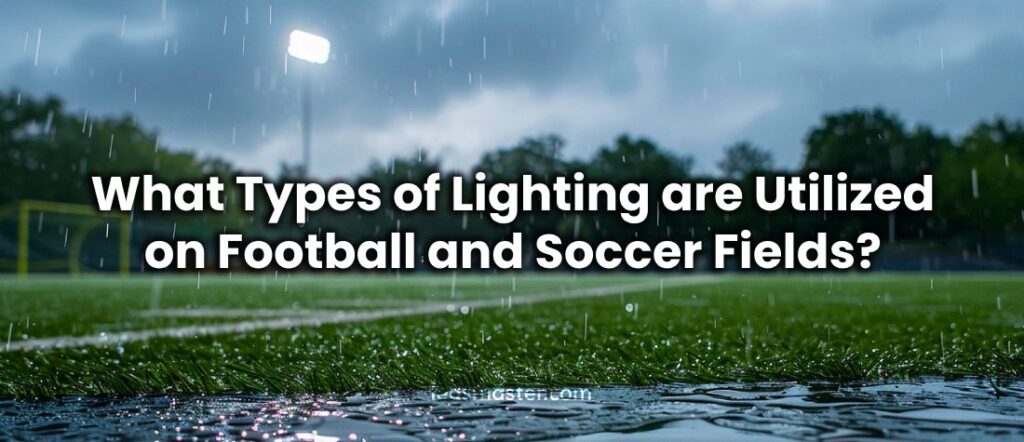After the hard work of building the football field, another crucial task lies in ensuring adequate lighting. Nearly every soccer field is equipped with specialized lighting systems designed to illuminate the expansive playing area. But what exactly are these lights called, and what types are typically used on football fields and soccer stadiums?
These lights are commonly referred to as floodlights, encompassing various specific types like football field lights, high mast lights, spotlights, soccer field floodlights, or soccer stadium lights. Each of these serves the singular purpose of flooding the field with light, enabling games to be played safely and effectively even after dusk.
Table of Contents
ToggleWhat Types of Lights were Employed on Football Fields in Earlier Times?
Historical Use of HID Lamps
In the past, football fields relied heavily on high-intensity discharge (HID) lamps for illumination. These lamps, including variants like metal halide, mercury vapor, and high-pressure sodium, were chosen primarily for their initial cost-effectiveness and wide availability.
Challenges with HID Football Field Lights
Despite their popularity, HID lamps consumed significantly more power compared to standard residential or commercial lighting. This higher energy requirement was necessary to ensure sufficient brightness across the expansive playing area. However, HID lamps were plagued by drawbacks such as prolonged warm-up times and relatively short lifespans.
Notable Incidents and Drawbacks
A notable incident occurred during the 2013 Super Bowl when a power outage was linked to the warm-up process of HID stadium lights. These lights typically took 10 to 20 minutes to reach full brightness, causing disruptions for players and spectators. Furthermore, HID lamps experienced poor lumen maintenance over time, often dimming after just a few years of use, necessitating frequent replacements.
Shift Towards Advanced Lighting Technologies
In response to these challenges, there has been a notable shift towards newer lighting technologies for football stadiums and soccer fields. These advancements aim to overcome the limitations of HID lamps by offering enhanced efficiency, quicker start-up times, and improved lumen retention throughout their operational lifespan.
Driving Innovation in Sports Lighting
The evolution of football field lighting underscores a continuous quest for optimal visibility and energy efficiency. Innovations in sports lighting technology are driven by the need to enhance player performance, spectator experience, and operational sustainability across sports venues worldwide.

What Kinds of Lights are Used on the Football Stadium Nowadays?
With the rapid advancements in technology, LED floodlights have become increasingly prevalent in modern football stadiums. These innovative lighting systems go by various names such as LED football stadium lights, football pitch floodlights, high mast floodlights, and more. The term “floodlights” encompasses these versatile lighting solutions designed specifically for illuminating football fields efficiently and effectively.
LED floodlights have gained popularity due to their numerous advantages over traditional lighting options. They offer superior energy efficiency, longer lifespan, and instant illumination without the need for warm-up time. This not only enhances visibility for players and spectators but also contributes to significant savings in energy costs and maintenance efforts.
Furthermore, the versatility of LED technology allows for precise control over lighting levels and distribution, optimizing conditions for gameplay and broadcast quality alike. As football stadiums continue to embrace LED floodlights, the evolution of sports lighting underscores a commitment to enhancing performance, sustainability, and spectator experience in modern sports venues.
| How do we call the lights on football field | Functions |
| Football field flood Lights | Illuminates the proximity of a football field with a wide beam of lights |
| Football field spotlights | Illuminate a farther area of a football field with concentrated lights |
| High mast stadium lights | The lights come from 12 to 60 meters (40 to 200 feet) tall light poles. |

Understanding Floodlights and Spotlights in Football Field Lighting
What are Floodlights and Why are They Used on Football Fields?
Floodlights are integral to illuminating football fields, providing a broad, wide-angle beam of artificial light that effectively floods the playing surface. The name “floodlight” derives from its ability to uniformly cover large areas with high brightness. This makes floodlights indispensable in football stadium lighting, ensuring optimal visibility for players and spectators alike. Beyond stadiums, floodlights find applications in various large outdoor settings due to their capability to illuminate expansive spaces efficiently.
Exploring Spotlights and Their Role in Football Field Lighting
Spotlights offer a contrast to floodlights with their focused beam angle, which directs light more narrowly and intensely onto specific areas of the football field. Unlike floodlights, which evenly distribute light across the playing surface, spotlights are ideal for illuminating precise locations such as corners and sidelines. This targeted illumination helps enhance visibility in critical areas of the field, ensuring clarity and detail during gameplay.
Integrating Different Lighting Fixtures for Optimal Field Illumination
In the comprehensive lighting design of football fields, a combination of floodlights, spotlights, and high mast lights is typically employed. Each type of fixture serves a distinct purpose in meeting the specific lighting requirements of different parts of the field. Floodlights provide overarching brightness, spotlights offer focused illumination where needed, and high mast lights ensure adequate coverage from elevated positions.
Enhancing Football Field Lighting Design
The evolution of football field lighting continues to advance with technological innovations that improve energy efficiency, light quality, and operational flexibility. Whether for a new stadium project or upgrading existing facilities, tailored lighting solutions play a crucial role in enhancing player performance, ensuring broadcast quality, and optimizing spectator experience.
Requesting a Lighting Design Consultation
If you’re planning a football field lighting project and would like expert guidance, our team of engineers offers complimentary photometric and lighting design reports. Contact us today to discuss your requirements and explore how we can assist in achieving optimal lighting solutions for your football facility.
Why do we Use LED Floodlights on Football Fields?
There are two common types of football field lights: LED and metal halide. In recent years, there has been a notable shift towards replacing metal halide or HID lights with LEDs. But why is this trend gaining momentum?
Advantages of LED Football Field Lights
Energy Efficiency
One of the primary reasons for switching to LED football field lights is energy efficiency. For instance, a high-quality 800W LED football flood and spotlight can effectively replace a 2000W metal halide lamp. This translates to a significant reduction in electricity consumption—up to 60%. For example, if the original monthly operating cost of traditional lights was $1,000, switching to LED lights could lower that cost to just $400 per month. LEDs achieve comparable brightness levels while consuming less electricity, resulting in substantial savings over time.
Higher Color Rendering Index (CRI)
LED football field lights offer a higher Color Rendering Index (CRI) of 95 or more. This characteristic is particularly crucial for televised events like FIFA or Premier League matches. High CRI lighting ensures that the true colors of the field and players are accurately represented, enhancing the viewing experience for spectators and ensuring optimal visibility for players.
Instant On and Off Capability
Unlike HID lights such as metal halide or mercury vapor lamps, which require 10 to 20 minutes to reach full brightness, LEDs operate on a different principle. They achieve maximum brightness instantly, in less than a second, upon being turned on. This instant on/off capability is convenient for football players, allowing for immediate visibility adjustments and reducing waiting times for spectators.
Dimmable Control
LED stadium floodlights support advanced dimming capabilities, which were challenging with traditional lighting technologies. Previous systems often faced issues with voltage stability when attempting to dim HID lights. In contrast, LED lights are compatible with DMX or DALI 0 to 10V systems, enabling precise control over brightness levels. This flexibility allows stadium operators to adjust lighting according to specific needs, whether for different game conditions or energy-saving initiatives.
Sustainability and Longevity
LED football field lights are renowned for their longevity and sustainability. They typically have a much longer operational life compared to metal halide lamps, which translates to reduced maintenance costs and fewer replacements over time. LED fixtures are also more environmentally friendly due to their energy efficiency, helping stadiums and sports complexes lower their carbon footprint.
Improved Uniformity and Glare Control
LED lights provide superior light distribution and control, offering improved uniformity across the playing surface. This enhanced uniformity ensures that players experience consistent lighting conditions throughout the field, reducing shadows and improving visibility. Additionally, LED fixtures can incorporate advanced optics to minimize glare, enhancing the comfort of both players and spectators.
Resistance to Vibrations and Impact
LED football field lights are solid-state lighting devices, meaning they do not contain fragile components like filaments or glass bulbs. This makes them highly resistant to vibrations and impact, making them suitable for outdoor environments where weather and physical impact can affect traditional lighting fixtures.
Smart Lighting Capabilities
Modern LED stadium floodlights often come equipped with smart lighting capabilities. This includes features such as remote monitoring, scheduling, and automated controls based on environmental conditions or usage patterns. These smart functionalities not only enhance operational efficiency but also contribute to energy savings by optimizing lighting usage.
Adaptability to Specialized Applications
LED technology allows for flexibility in design and application. Stadiums can customize their lighting setups to meet specific requirements for different sports events or activities. Whether it’s adjusting lighting levels for training sessions, matches, or entertainment events, LEDs offer the versatility to create optimal lighting environments tailored to diverse needs.
Improved Safety and Security
LED lights contribute to enhanced safety and security in sports facilities. Their instant on/off capability ensures immediate illumination during emergencies or power outages, aiding evacuation procedures. Moreover, the consistent brightness and color rendering provided by LEDs help security personnel monitor the venue more effectively.
Conclusion
The widespread adoption of LED football field lights represents a significant advancement in sports lighting technology. Beyond energy efficiency and cost savings, LEDs offer superior performance, durability, and adaptability that align with the evolving needs of modern sports venues. As stadiums continue to prioritize sustainability, performance, and spectator experience, LED lighting solutions remain at the forefront of innovation in sports facility management.

